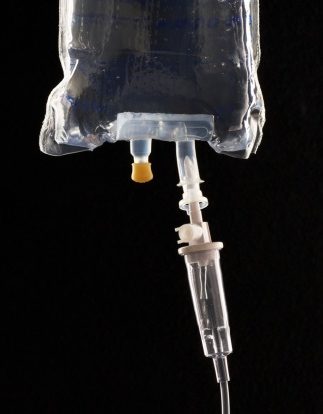
Dysautonomia is the kind of illness that can present different symptoms in different patients. When the autonomic nervous system misfires and dysfunctions, it can leave a patient with a host of perplexing symptoms that affect nearly every major organ system in the body. From heart-pounding Postural Orthostatic Tachycardia to painful gastroparesis and disorienting migraines—this is an illness that is difficult to diagnose, and even more difficult to treat. I have become adept at recognizing the underlying connections and searching for therapies that alleviate the symptoms without producing new complications to deal with.
One of the treatments I prescribe for my patients with Postural Orthostatic Tachycardia Syndrome is Intravenous Saline Therapy. Dysautonomia (POTS in particular) is treated with a variety of symptom-based prescriptions including cardiac rehab, dietary changes, vitamins and supplements therapies. Intravenous saline therapy can begin to calm many symptoms of and provide quick relief to a suffering patient with little or no appreciable side effects.
What is POTS?
Postural – Dependent on posture.
Orthostatic- Referring to the upright or vertical.
Tachycardia- Accelerated heart rate (fast heartbeat.)
Syndrome.
Put it all together and it refers to a syndrome characterized by an increase in heart rate by 20-30 beats per minute or more when the person stands up.
This fast heart rate is abnormal and can lead to dizziness, weakness or even fainting. The normal person will respond to standing up with NO noticeable change in heart rate. The heart and blood vessel system has an automatic compensation system which seems to fail for some unknown reason in the person who develops POTS.
The increase in heart rate can be associated with a drop in blood pressure, no change in blood pressure or an increase in blood pressure, depending on the patient.
It is important to realize that this condition can occur suddenly or gradually in a person who was completely fine previously and never had anything like it before.
How does IV Saline Therapy improve POTS Symptoms?
IV Saline is an isotonic solution used to maintain adequate hydration in many clinical settings. The term “isotonic” suggests that it has the same density as normal blood and contains the same amounts of sodium and chloride ions as normal blood so that electrolyte balance will not be affected. We all know instinctively that we cannot drink sea water because it is “hypertonic” and would cause our brain to shrink up and we would die from the excess amount of sodium and chloride per unit volume of water. What is less well appreciated is that we would also become very sick from drinking excessive amounts of “free water” i.e. water with NO sodium or chloride in it. This would profoundly dilute the concentrations of sodium and chloride in the bloodstream and would not be good for heart and brain function.
By using one liter of IV saline we safely expand the circulating blood volume without affecting the sodium and chloride (“electrolyte”) concentrations. The circulating blood volume of a normal sized individual is approximately 5 liters so we are increasing it by about 20%. This can significantly help with supporting upright blood pressure and slowing the reflex tachycardia.
There is no major difference between Normal Saline (also called .9% Sodium Chloride solution) and Ringer’s Lactate when it comes to the purpose of re-hydration. They are equally useful for expanding intravascular volume. The rate of administration for a young person should range around 300cc/hour up to 1000cc/hr depending upon tolerance of the individual. Many of my young, otherwise healthy patients start out at one liter over three hours and want to speed it up and spend as little time hooked up as possible, so we comfortably get up to one liter over one hour. That gives them more time to go out and enjoy the benefits of the increased energy and strength they obtain from the infusion. Patients have reported that IV therapy has lessened their fatigued, improved gastric motility, migraines, joint pain and can often assist with calming tachycardia.
How Can Patients Access Saline IV Therapy?
I’ve rarely come across fellow physicians who offer IV’s in their office, as I do. It is such a simple therapy to provide for patients, but many doctors do not have the time or resources to establish infusion centers within their daily practice. Patients can find assistance at walk-in clinics or emergency rooms .Many of my patients now receive IV therapy in their own homes as the growth of home infusion nursing capabilities has taken place in South Florida. They may also be able to work with their physician to schedule IV’s on a weekly basis at a local infusion center. This is usually covered by insurance. It is best to give saline preemptively on a regular schedule instead of on an emergency basis when a patient is already in the depths of their worst symptoms. Regular hydration can provide a sense of stabilization and normalcy for patients, allowing them to have more control over their bodies, health and ultimately—their lives.
For more information on receiving saline therapy through Santa Maria Medicine please call 561-338-0737